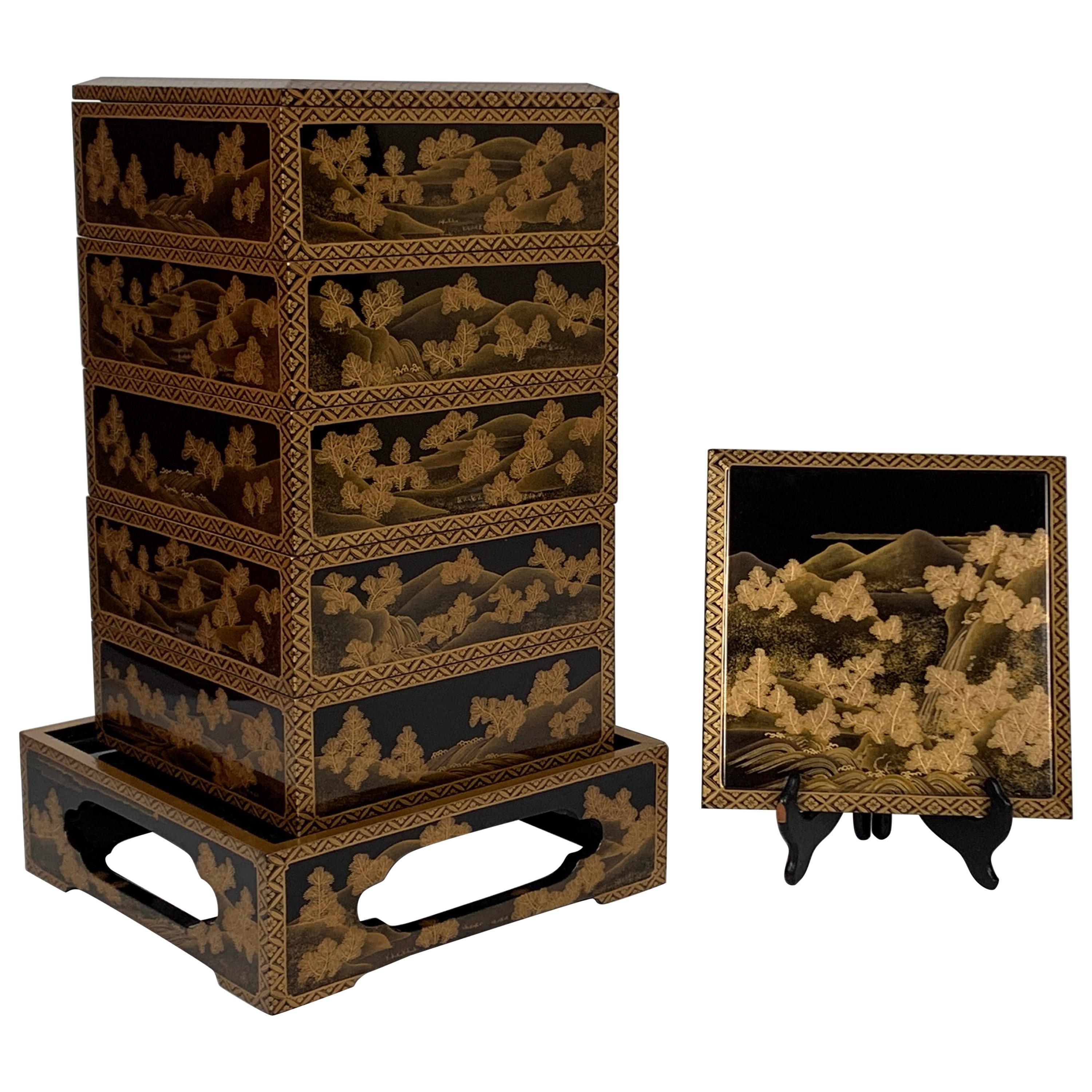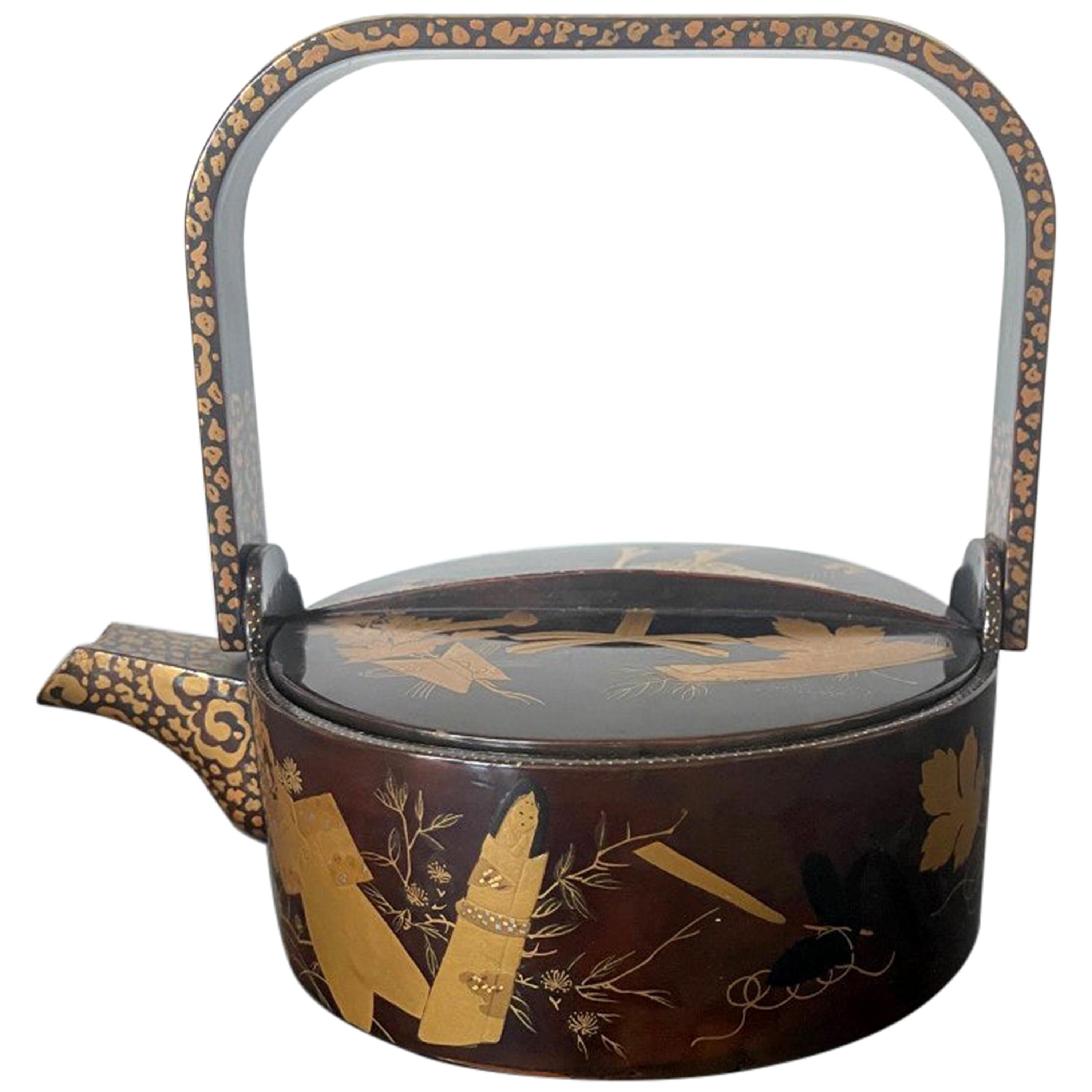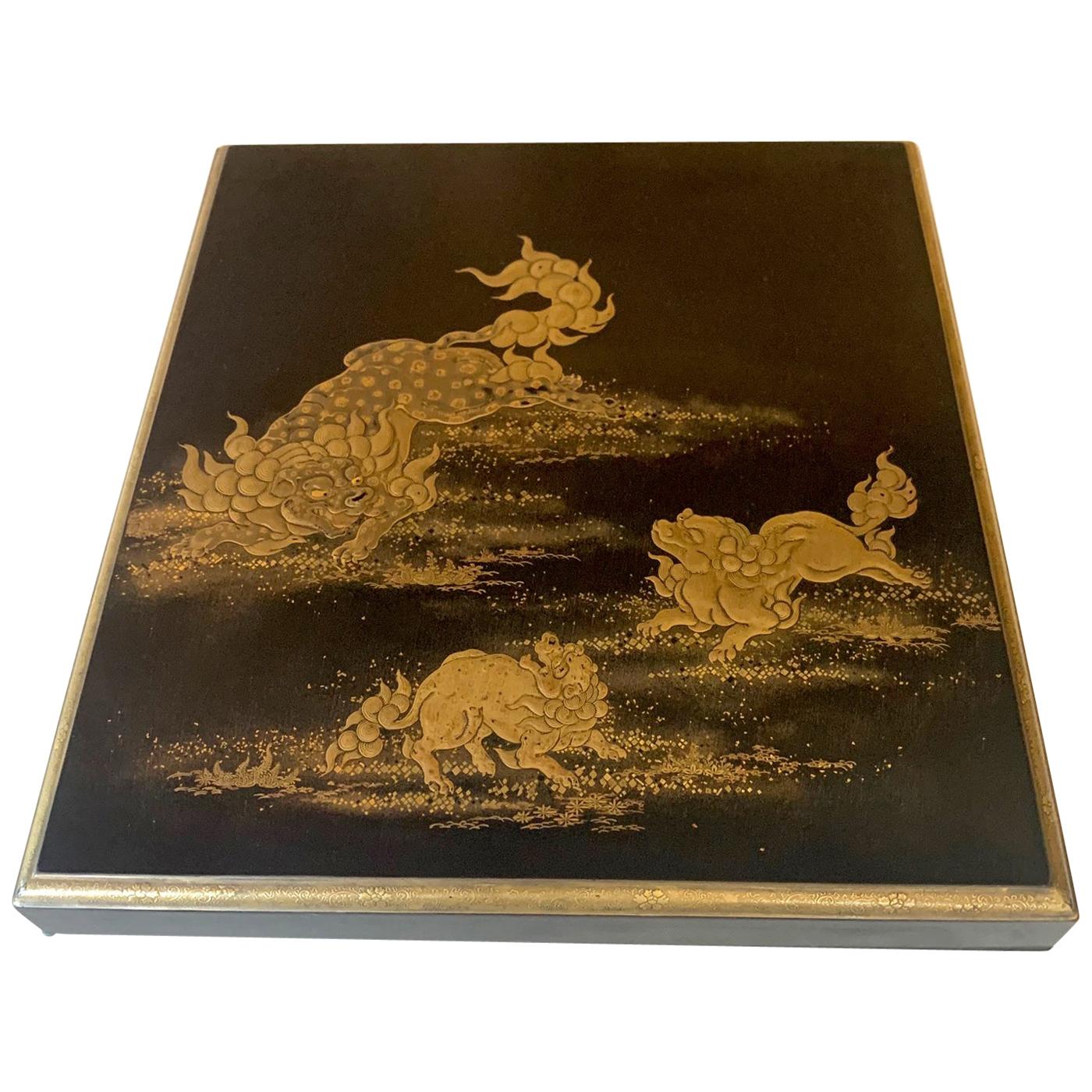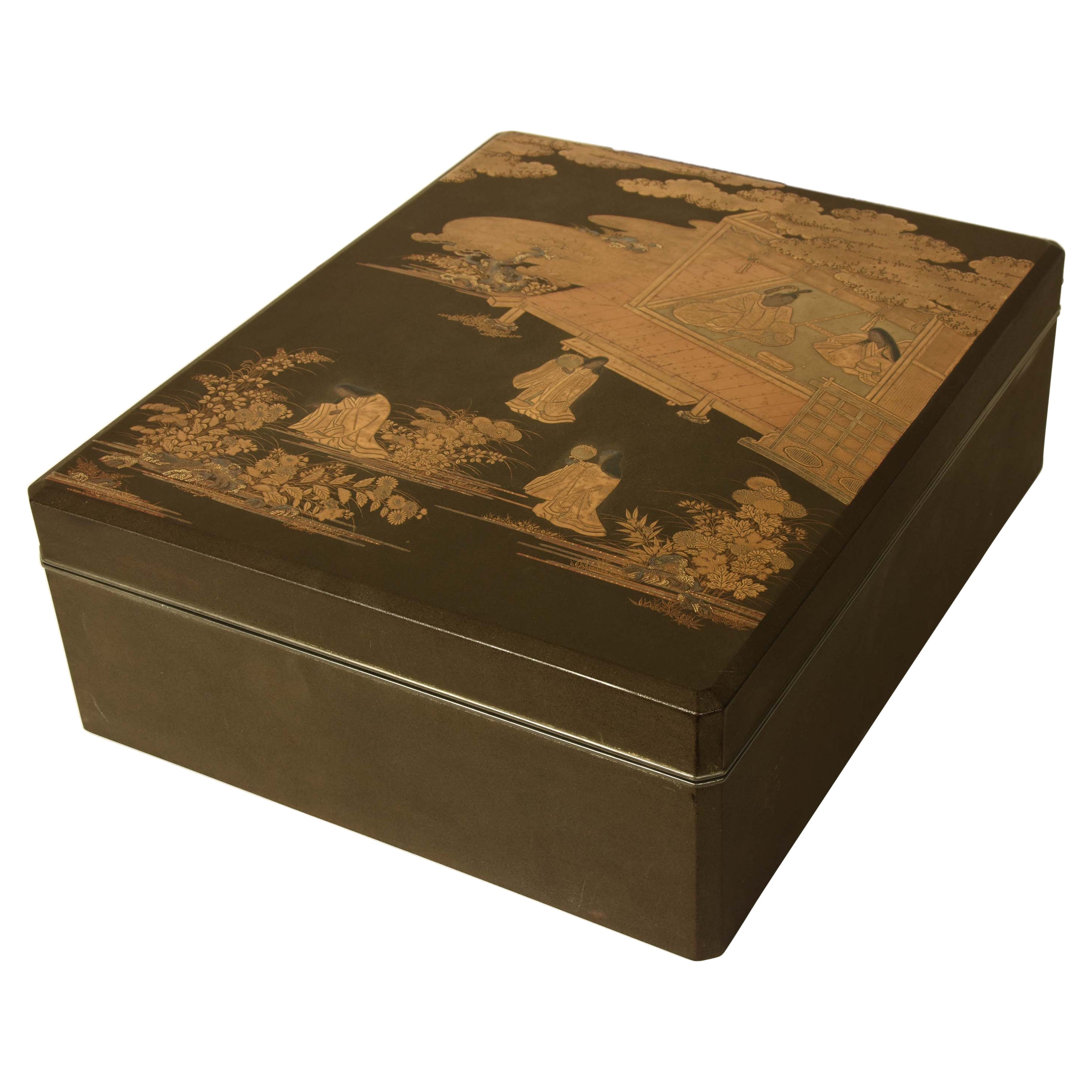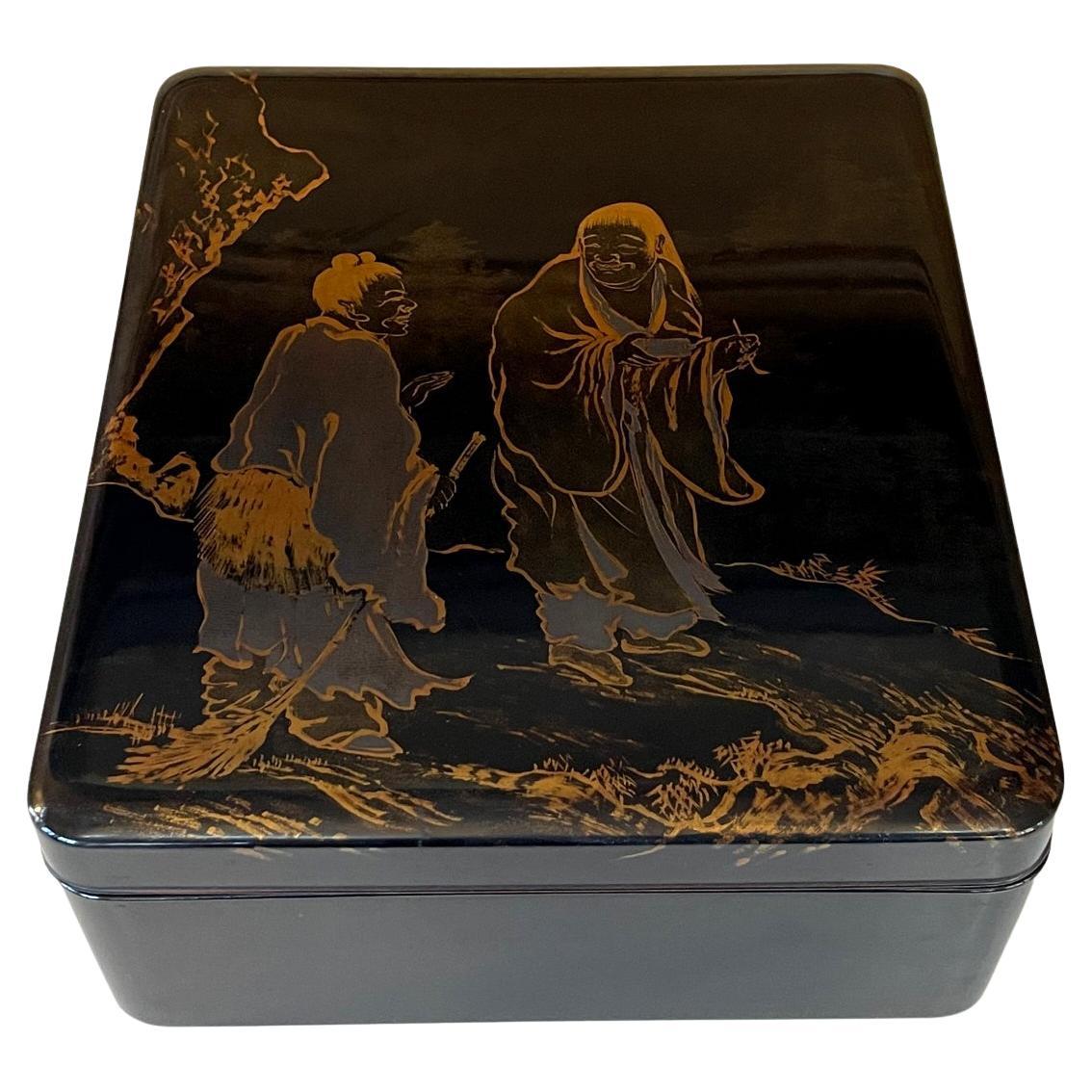Items Similar to Signed Japanese White Lacquer and Maki-E Lacquer Tansu, Meiji Period
Want more images or videos?
Request additional images or videos from the seller
1 of 9
Signed Japanese White Lacquer and Maki-E Lacquer Tansu, Meiji Period
About the Item
The case decorated overall in crackle-glaze white lacquer and fitted with a patinated metal carrying handle over three tiers of small drawers. The first two tiers are comprised of a pair of short off-set drawers with organic-inspired metal pulls, over a single lower drawer fitted with a patinated metal bail handle, their fronts decorated with hand applied gold maki-e lacquer depicting a songbird amongst flowering branches.
Signed in characters on the underside.
- Dimensions:Height: 6 in (15.24 cm)Width: 6 in (15.24 cm)Depth: 3.25 in (8.26 cm)
- Style:Meiji (Of the Period)
- Materials and Techniques:
- Place of Origin:
- Period:
- Date of Manufacture:1868-1912
- Condition:Wear consistent with age and use. In very good overall condition with minor losses to the glazing.
- Seller Location:Ottawa, CA
- Reference Number:1stDibs: LU272837668143
About the Seller
5.0
Gold Seller
These expertly vetted sellers are highly rated and consistently exceed customer expectations.
Established in 1989
1stDibs seller since 2017
116 sales on 1stDibs
Typical response time: <1 hour
- ShippingRetrieving quote...Ships From: Ottawa, Canada
- Return PolicyA return for this item may be initiated within 2 days of delivery.
More From This SellerView All
- Highly Decorative Antique Burmese Lacquered Betel Box / Kun-It, Circa 1900Located in Ottawa, OntarioThe vermillion lacquered cylindrical body decorated overall with repeating bands of curvilinear geometric motifs, the cover lifting to reveal both of its original trays intended to h...Category
Early 20th Century Burmese Lacquer
MaterialsLacquer, Bamboo
- A Very Fine Takamaki-e Lacquer Cheroot Case in the Manner of Shibata ZeshinBy Shibata ZeshinLocated in Ottawa, OntarioThe 'ishime' lacquered case consisting of two conforming molded sections with one sliding overtop the other, both sides decorated with hand painted gilt, silver & burnt dark russet (kasshoku) lacquers, depicting motifs in low relief of a rat with an acorn on one side and two acorns on the opposing. In Japanese culture rats are considered auspicious symbols of fertility & wealth, acorns symbolize prosperity & growth. Signed with characters and a mon on one edge. Takamaki-e is a lacquer technique in which metallic powders such as silver, gold, copper, pewter etc., are used in combination with lacquer & clay-dust to build up motifs in low relief. Please note that the color tones & hues of the lacquered motifs appear somewhat more vibrant in the images due to ambient lighting conditions. Regarding the opinion stating the superior quality of this fine example being likened to works associated with those by Shibata...Category
Antique 1870s Japanese Meiji Lacquer
MaterialsLacquer
- Very Fine & Large Japanese Bronze & Mixed Metal Vase, Meiji PeriodLocated in Ottawa, OntarioA large and very fine Meiji Period (1868-1912) patinated and mixed metal bronze vase of ovoid form, richly decorated with raised motifs of flying cranes accented with silver-overlay,...Category
Early 20th Century Japanese Meiji Metalwork
MaterialsSilver, Bronze
- A 19th Century Japanese Patinated Bronze 'Suiteki' Water Dropper, Meiji PeriodLocated in Ottawa, OntarioA fine 19th century scholarly object used to moisten inksticks for an inkstone when working with calligraphy. Naturalistically cast in the form of a gourd with a detachable leafy st...Category
Antique Late 19th Century Japanese Meiji Scholar's Objects
MaterialsBronze
- A Very Fine Miniature Japanese Mixed Metal Bronze Bottle Vase, Meiji PeriodLocated in Ottawa, OntarioThe finely proportioned ovoid shaped body rising to an elongated slender neck with a flaring rim, decorated with motifs of waterfowl standing in a grassy marsh with silvered bodies, ...Category
Antique Late 19th Century Japanese Meiji Metalwork
MaterialsGold, Silver, Bronze, Copper
- A Very Fine Japanese Mixed Metal Bronze Doban / Suiban, Meiji Period (1868-1912)Located in Ottawa, OntarioDoban are traditional Japanese bronze vessels used to display scholarly objects known as ‘Suiseki’ (water stones), whereas a Suiban is a traditi...Category
Early 20th Century Japanese Meiji Scholar's Objects
MaterialsBronze
You May Also Like
- Japanese Maki-e Lacquer Stacking Box, Jubako, Meiji Period, JapanLocated in Austin, TXA fine and impressive Japanese gold maki-e decorated black lacquer five-tier jubako with presentation tray, two lids, and the original tomobako storage box, Meiji period, late 19th c...Category
Antique Late 19th Century Japanese Meiji Lacquer
MaterialsLacquer
- Japanese Lacquer Maki-e Sake Ewer Meiji PeriodLocated in Atlanta, GAA Japanese lacquered wood sake ewer with maki-e design, circa late 19th century, Meiji period. The nicely decorated lacquerware is of a Classic sake ewer for...Category
Antique 1890s Japanese Japonisme Lacquer
MaterialsLacquer
- Japanese Meiji Period Antique Lacquer Box with Gold Maki-e DecorationLocated in New York, NYA fine antique Japanese Meji Period lacquer box decorated with a fan and a stylized star shaped window in the maki-e technique. The fan at the top right corner, fully opened depictin...Category
Antique 19th Century Japanese Meiji Lacquer
MaterialsLacquer
- Japanese Lacquer Box with Fine Maki-e Decoration Meiji PeriodLocated in Atlanta, GAA lacquered wood box with lid from Japan circa 19th century Meiji Period. The finely decorated box was used to store paper slips and small documents on the desk. It is overall finished with black lacquer (kuro) with sparse Mura-Nashiji effect outside and on the top surface of the lid, there are three Komainu, (sometimes known as Shishi or Japanese lions) frolicking and forming a circle in lively motion. Komainu are auspicious animals in Japanese cultures in both Shinto and Buddhism tradition. Originally from China, these animals symbolizes guardians to ward off evil spirits. Hiramaki-e was used in combination with carving and combing to render the lions with various surface textures. A gilt border with an slight angle was given to the lid and even the thin band is decorated with miniature floral scrolls. The interior of the box was finished in a dense nashiji. Underneath the lid, a cluster of peonies open lavishly by two gentle mounts. Takamaki-e (high relief) in both gold and silver were...Category
Antique Late 19th Century Japanese Japonisme Lacquer
MaterialsWood, Lacquer
- Japanese Black Lacquer Document Box with Gold Maki e Design, Meiji PeriodLocated in Prahran, VictoriaAn antique black lacquer document box with an exquisitely detailed, finely wrought design from The Tale of the Genji depicted in gold maki e across the lid. Internally, the box is de...Category
Early 20th Century Japanese Lacquer
MaterialsWood, Lacquer
- Japanese Marquetry and Lacquer Jewelry Chest, Meiji Period, circa 1900, JapanLocated in Austin, TXA very attractive Japanese wood table top jewelry or collector's chest with marquetry and lacquer decoration, Meiji period, circa 1900, Japan. Previously in the collection of Asbjorn Lunde (1927 - 2017). The chest is crafted in the form of a Chinese seal...Category
Antique Early 1900s Japanese Meiji Lacquer
MaterialsWood, Softwood, Lacquer
Recently Viewed
View AllMore Ways To Browse
White Lacquer Furniture
White Lacquer
Century Furniture White Lacquer
Pair Lacquer
Lacquer Organic
Lacquer With Drawer
Off White Antique Furniture
Antique Furniture Pull Handles
Antique Furniture Handles And Pulls
Drawer Handles And Pulls
Antique Painted Metal Sign
Japanese Lacquer Set
Antique Crackle Glaze
Bail Handles
Pair Japanese Lacquer
Pair Of Japanese Lacquer
White Lacquer Asian
Asian Painted Drawers
